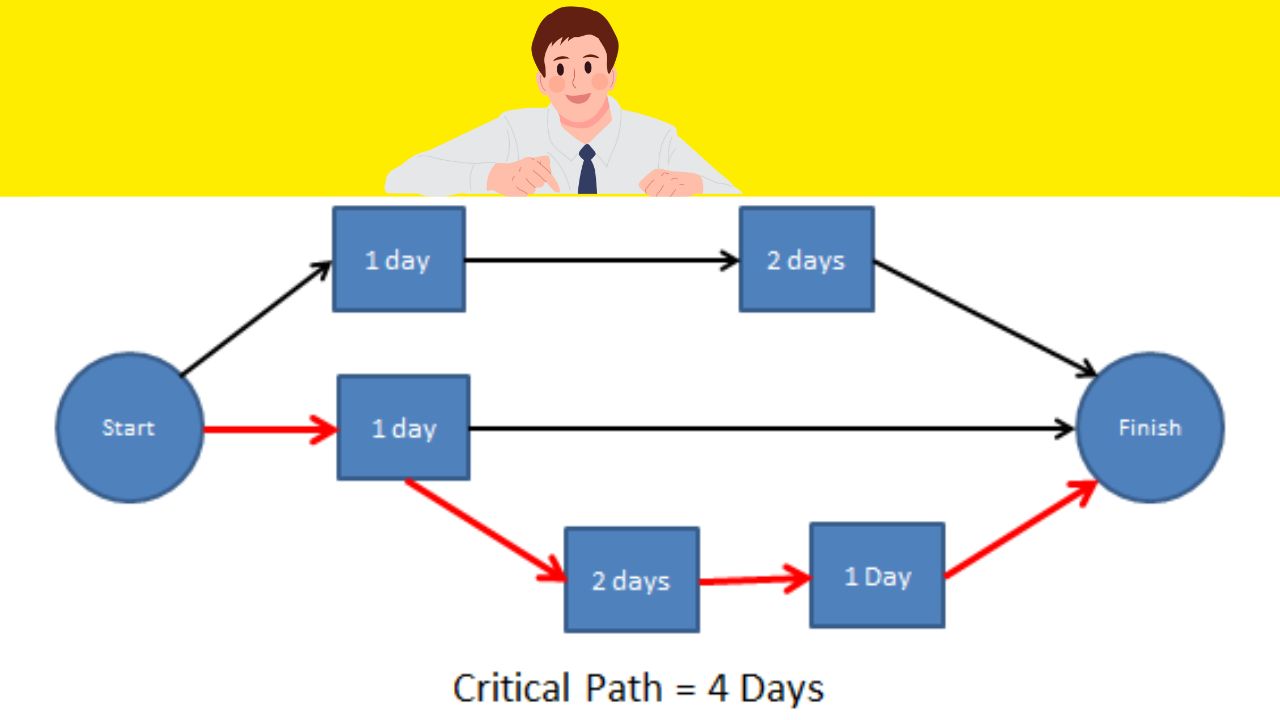Have you ever wondered how top project managers consistently keep their projects on track, even when faced with tight deadlines and shifting priorities? One of the most powerful techniques they rely on is the Critical Path Method (CPM).
Critical Path Method helps project managers identify the most essential tasks that directly impact a project’s completion date. It highlights the sequence of dependent activities that, if delayed will delay the entire project, that path is a ‘critical path’ in the project flow.
In this article, I will discuss the Critical Path Method (CPM) in detail along with its benefits and limitations, as well as how to identify a critical path in the project step by step with a practical example.
When you understand CPM, you gain the ability to allocate resources more efficiently, forecast potential roadblocks, and take proactive measures to keep your project on track. Are you ready to master CPM? Then let’s get started…
What is the Critical Path Method (CPM)?
In project management, staying on schedule, within budget, and meeting goals are vital for success. The Critical Path Method (CPM) is a proven technique that helps project managers achieve these objectives by identifying key tasks and ensuring resources are focused on them.
This guide explores what the Critical Path Method (CPM) is, why it matters, its essential components, how it can be applied across various industries, and its relevance for modern-day project management professionals.
Whether you’re a seasoned project manager or new to the field, you’ll find practical insights to enhance your projects.

At its core, the Critical Path Method is a project planning strategy that highlights the sequence of tasks that must be completed on time to avoid delays in the overall project. These tasks form the “critical path,” which represents the minimum duration required to finish the project.
If a critical path task is delayed, it directly impacts the project timeline. Therefore, understanding and managing the critical path is essential for project success.
The Critical Path Method was developed in the late 1950s by James E. Kelley and Morgan R. Walker while working on projects for DuPont and Remington Rand.
It was initially created to manage complex construction projects and quickly became a cornerstone in project management across industries.
Over the decades, CPM has evolved with the introduction of software tools, making it more accessible and efficient for modern-day projects.
Key Elements of the Critical Path Method
To grasp the Critical Path Method fully, it’s important to understand its building blocks:
1. Tasks or Activities
These are the individual components of the project. Each task has a clear start and end and may rely on other tasks to begin.
2. Task Dependencies
Tasks often depend on others to proceed. For instance, you can’t assemble furniture without first building its parts. Dependencies in the Critical Path Method include:
- Finish-to-Start (FS): Task B starts only after Task A finishes.
- Start-to-Start (SS): Task B starts as soon as Task A starts.
- Finish-to-Finish (FF): Task B finishes only when Task A finishes.
- Start-to-Finish (SF): Task B finishes only when Task A starts.
3. Task Durations
This refers to the time required to complete a task. Accurate estimates are essential for reliable scheduling.
4. Critical Path
The critical path is the longest chain of dependent tasks. It determines the shortest time needed to complete the project.
5. Slack Time
Slack or float is the amount of time a task can be delayed without affecting the project timeline. Tasks on the critical path have zero slack.
How to Apply the Critical Path Method?
Using CPM involves a systematic approach to identifying and managing the critical path. Here’s how it works:
Step 1: List All Tasks
Create a comprehensive list of every task required to complete the project. A Work Breakdown Structure (WBS) can help ensure no task is overlooked.
Step 2: Define Dependencies
Determine how tasks relate to one another. For example, if Task A must finish before Task B begins, this dependency needs to be mapped.
Step 3: Estimate Task Durations
Assign realistic time estimates to each task. Use historical data or expert input for accuracy.
Step 4: Create a Network Diagram
Visualize the sequence of tasks and their dependencies using tools like Gantt charts or activity-on-node diagrams.
Step 5: Perform Forward and Backward Pass Calculations
- Forward Pass: Identify the earliest start and finish times for each task.
- Backward Pass: Determine the latest start and finish times without delaying the project.
Step 6: Identify the Critical Path
Find the sequence of tasks with zero slack. These are the critical path tasks requiring close monitoring.
Step 7: Update the Schedule
As the project progresses, adjust the schedule to reflect changes and ensure the critical path remains manageable.
Advanced Concepts in the Critical Path Method
1. Resource-Leveling
Resource-leveling adjusts the schedule to address resource constraints while minimizing delays. It ensures that tasks on the critical path are completed efficiently without overloading resources.
2. Crashing and Fast-Tracking
- Crashing: Involves adding more resources to critical path tasks to reduce the project duration.
- Fast-Tracking: Allows overlapping of tasks that were previously planned to be sequential, saving time but increasing risks.
3. Monte Carlo Simulations
Advanced software can predict project outcomes using simulations, accounting for uncertainties in task durations and resource availability. (Check out – Critical Path Method Software)
Benefits of the Critical Path Method
The Critical Path Method is widely used because it offers several advantages:
1. Clearer Project Planning
It provides a structured framework that makes it easier to visualize the project timeline and identify potential bottlenecks.
2. Better Resource Management
By focusing on critical tasks, resources can be allocated efficiently to avoid delays.
3. Proactive Risk Management
Knowing the critical path helps project managers foresee risks and take corrective actions before issues escalate.
4. Improved Decision-Making
With a clear understanding of task priorities, project managers can make informed choices to keep the project on track.
5. Increased Accountability
Everyone involved in critical tasks understands their importance, fostering a sense of responsibility.(Check out – 7 Management Tools Every Manager Should Know)
Real-World Applications of the Critical Path Method
The Critical Path Method is versatile and applicable across many industries. Here are some examples:
1. Construction Projects
Construction managers use CPM to schedule activities like foundation laying, framing, and inspections, ensuring timely completion.
2. Software Development
In software projects, CPM helps coordinate coding, testing, and deployment phases, keeping the project aligned with deadlines.
3. Event Planning
From organizing weddings to corporate events, CPM ensures every detail, like venue booking and vendor coordination, is managed effectively.
4. Manufacturing
Manufacturers rely on CPM to streamline production schedules, reduce downtime, and meet delivery deadlines.
How the CPM Compares to Other Tools?
While the Critical Path Method is a powerful tool, it’s helpful to understand how it differs from other techniques:
1. CPM vs. PERT
- CPM: Uses fixed task durations, making it ideal for predictable projects.
- PERT: Focuses on probabilistic task durations, better suited for projects with uncertainty.
2. CPM vs. Gantt Charts
- CPM: Emphasizes task dependencies and the critical path.
- Gantt Charts: Offers a visual timeline but may not highlight dependencies as effectively.
Challenges of Using the CPM
Although effective, CPM has its challenges:
1. Reliance on Accurate Data
If task durations or dependencies are incorrect, the entire schedule can be compromised.
2. Complexity in Large Projects
For projects with hundreds of tasks, managing the critical path manually can be overwhelming.
3. Frequent Updates
Dynamic projects require continuous updates to the critical path, which can be time-consuming.
Future of the CPM
As technology advances, CPM continues to evolve:
- AI Integration: Predictive analytics and artificial intelligence are improving the accuracy of critical path calculations.
- Real-Time Updates: Cloud-based tools provide instant updates, allowing project managers to react to changes faster.
- Increased Automation: Software automates complex tasks, freeing up time for strategic decision-making.
Tips for Maximizing the CPM
To get the most out of CPM, consider these tips:
1. Leverage Project Management Software
Tools like Microsoft Project or Primavera can simplify calculations and updates.
2. Regularly Monitor Progress
Keep the schedule updated to reflect the current status of tasks.
3. Train Your Team
Ensure team members understand their roles in tasks along the critical path.
4. Incorporate Buffers
Include extra time for non-critical tasks to absorb potential delays.
Want to master Project Management in detail I would suggest you join the Google Project Management Professional Certification Program.
This program will help you master project management tools practically with real-life case studies. Simply click on the above link and search the project management.
Conclusion
Critical Path Method (CPM) offers a laser-focused view of the tasks that truly matter, highlighting the critical activities that must be completed on time to keep your project on track. CPM turns complexity into clarity and gives you control over your project’s timeline.
By identifying the longest path of dependent tasks, you gain the power to manage time, resources, and risks more effectively. It provides a clear picture of where your attention should be, helping you confidently steer your project toward successful completion.
By integrating the Critical Path Method into your project management toolkit, you empower yourself to stay ahead of the potential risks, meet deadlines consistently, and deliver results that exceed expectations.
If you found this article useful then please share it in your network and subscribe to get more such articles every week.





